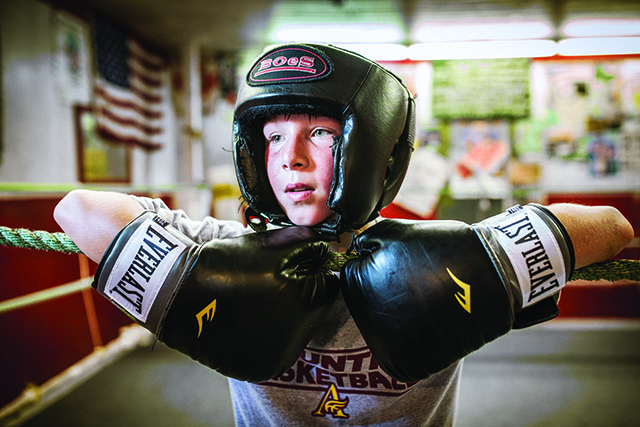Training men first and boxers second.
Dan Rossignol’s rapid-fire fists unleash a flurry of blows on a well-worn speed bag. In a boxing ring a few steps away, the RCMP officer’s seven-year-old son, Lucas, spars with an older boy, much like his old man did nearly 30 years ago. Across the cramped room, former Canadian champ Mark Adams chats with an old friend and happily looks on at the piece of Atlantic tradition he’s helping to preserve. It’s a familiar sight at Bob Edgett’s Boxing Club: multiple generations of boxers under one roof. These men grew up here, though the one who brought them to this nondescript shack in the middle of the marsh so many years ago won’t be back again.
For 58 years, until his death in 2011 at the age of 81, Edgett ran his boxing club out of this “sweat mine,” as it’s affectionately known. Once part of the old Mount Allison University gymnasium in Sackville, N.B., Edgett purchased the tiny structure for $100 in 1951 and had it moved to its present location near the outskirts of town on York Street in order to pursue his dream of starting a club for local boys. Since then, nearly 10,000 kids have come through the doors (girls started coming in the ’90s), all free of charge. Today, the red paint on the clapboard building is all but completely peeled, and the fight posters littering its walls are fading thanks to a half-century of sun exposure. There is still no running water. No change rooms. Though that “minimalist” state has long been part of the gym’s appeal, its days are numbered. Just before Edgett passed, then-mayor Patricia Estabrooks suggested a “living monument” be built to honour a lifetime of community work through the club by replacing it with an upgraded building equipped with modern facilities. And so, with the support of the community, Adams, Rossignol and a committee of other former Edgett disciples have taken up the cause, working to raise the nearly $300,000 it will take to complete the project.
Sackville is a small, pretty town with two traffic lights set in the marshlands of southeast New Brunswick. It would be almost entirely rural if it weren’t for the university that occupies much of its centre. Notable exports include red stone from the nearby quarry, which can be spotted in buildings across the country (Queen’s Park in Toronto is made of Sackville stone); painter Alex Colville; 51 Rhodes Scholars from Mount Allison; and Edgett-trained boxers. Under Edgett, Adams won two New England titles in ’78 and ’83, and was Canadian lightweight champion after turning pro. Rossignol won bronze in the Canadian nationals as a 15-year-old and a silver at 17 before competing in two Olympic trials—for the Atlanta Games in ’96 and for Sydney in 2000. Other well-known Maritime boxers like Les Sprague of nearby Amherst, N.S., and Yvon Durrelle of Baie-Ste-Anne, N.B., who once fought Archie Moore, were trained by Edgett.
Born in nearby Centre Village, N.B., Edgett was known around Sackville as a jovial giant, always as quick with a joke as his boxers were with their jabs. The six-foot-two, 230-lb. former Canadian Navy boxing champ (he served at sea following the Second World War) was a successful amateur whose career was cut short when he lost a kidney in a construction accident. He returned to Sackville a hero. “If there was one motivating factor for Bob to start the club, I don’t know,” says childhood friend Wallie Sears, whose father introduced Edgett to boxing in the family barn when the two were teens. “Some of us commit our lives to one thing, and Bob committed his to the children of this community. For many years here, he was Sackville’s only recreational department.”
For decades, Edgett was as much a community landmark as Waterfowl Park, which zigzags its way through town. The Bob Edgett Award was given out to the athlete of the year at a local consolidated school, and the kids’ faces would light up when Bob showed up year after year to personally hand out the trophy. When a local home or business was destroyed by fire, for instance, he would gather his boys and put on exhibition matches around town, with the proceeds going to those in need; in his later years, he would carry around suckers in his pocket and hand them out like Santa Claus to anyone he passed. At local parades, the club’s van could be found atop a float with “Thank You Sackville!” scrawled along its exterior.
By day, Edgett worked as a guard at the maximum-security prison in Dorchester, N.B., about 15 minutes west of Sackville, clocking overtime to fund the club’s expenses. Over the years, he poured tens of thousands of his own dollars into the club. He often brought his students to the prison to perform exhibitions for the inmates. He would also contact administrations in Maine and New York, and Edgett and his boys became a travelling show of sorts, piling into the van in their matching red jackets with “BEBC” stitched across the back to perform in prisons on both sides of the border. In some cases, the kids would even go in the ring against the inmates. “We always felt safe around Bob,” says Adams. “There was never a feeling of being nervous when he was around.” As Rossignol recalls, “It was always a big test for us, because we had to learn how to stay cool, calm and collected under pressure, fighting in front of a crowd against grown men serving life sentences. But he was always teaching us that these inmates were people, too. Bob judged nobody. They were serving some hard time, and may have deserved to have been there, but they were still human beings. Bob thought that of everyone. Everybody deserved a second chance, and to be treated with respect.”
The locals call them “non-joiners,” the kind of kids who weren’t exactly Boy Scout material. That was who Edgett recruited, and he soon became known as the RCMP’s best friend. “A lot of them were the ‘dead-end’ kids,” says Sears. “They’d think they were tough, then they’d get in the ring and find out they weren’t so tough. They’d calm down, get back in the ring, and that was the start of them becoming men. He made it his business to make gentlemen of these rough boards, so to speak.”
Yet, that wasn’t exclusively the makeup of Edgett boxers. A six-year-old Adams fell in love with the sport after simply following in the footsteps of his two older brothers, who had been training with Edgett for years. Meanwhile, Rossignol’s dad worked with Edgett at the penitentiary and first took him to the BEBC when he was seven so he could give boxing a try.
As he learned, entering the doors of that gym made you a friend of Bob’s for life. When Rossignol enlisted in the military shortly after his Sydney Olympic trial, he paid a visit to Edgett’s home days before deployment to Afghanistan. Rossignol took comfort in simply being there, sitting back and hearing Edgett tell stories from his own military days. “Not knowing what lay ahead, I needed that,” he says. “Bob was like a second dad in that respect. To be honest, I think I spent more time with him than my own dad. He was always somebody I looked up to, somebody who made me feel proud. He had that kind of faith in people that they could do anything they wanted.”
It’s with that confidence that Adams, Rossignol and the committee are going forward with the plans to rebuild the club. Adams—who works for Mount Allison’s facilities department and became more and more involved in the gym as Bob’s health deteriorated, driving his mentor to and from the club (“He did it for me when I was a kid,” he reasons)—has decided to pick up the mantle and continue Bob’s legacy. “I’m just trying to follow the same path, helping to keep kids interested in boxing.” He recently became a certified boxing coach, and while the group is still awaiting federal certification as a charitable organization, things are moving swiftly ahead. A local architect has drawn up plans for the updated gym, and a former club member who runs a successful construction company in the region has agreed to clear the site and lay the foundation for the new building, pro bono. Adams is adamant about running the club just like Bob did; it will continue to be open to anybody who walks through its doors and will remain free for members, as it’s always been.
Edgett was and remains highly respected throughout the Canadian boxing community—he’s a member of the CABA Hall of Fame—and had an opportunity to coach the senior national team, but turned it down in favour of taking the reins of the intermediate group instead. He never got his accreditation as a professional coach; working on that side of boxing never appealed to him. He wasn’t interested in training boxers; he was training men. At his wake, one after another, his boxers spoke. “Bob showed me how to properly shake someone’s hand,” one said. “He taught me to say ‘please’ and ‘thank you,’” said another.
“I strive to be polite and courteous to everybody,” says Rossignol. “My nickname around town was ‘The Gentleman.’ And that was because of Bob Edgett.”


